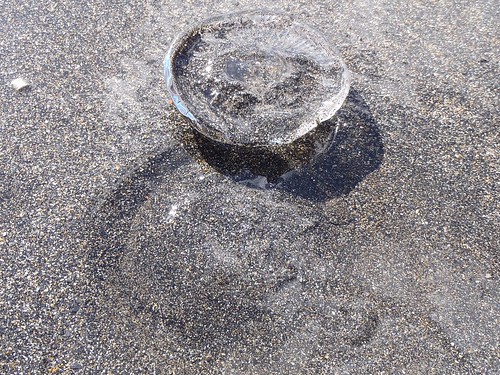This is the actual impression that the jellyfish left on the sand after Joe carefully turned it over. Note the complete lack of any recognisable features. All the other jellyfish that we looked at showed the same thing. This would seem to indicate that, even if an impression of a jellyfish were to make it into the fossil record, it would not be recognisable.
Of course, these were only a few examples, and we might just have been unlucky. Perhaps other jellyfish are more obliging? Back in Nanjing, I went to the library for information on what happens to jellyfish after they die, and found a book chapter written by David Bruton in 1991. He found that the animals can leave well-defined impressions on sand, but only if they dry out, for example if they are thrown up above the high tide line. This explains why the Abereiddy jellyfish didn’t leave any recognisable marks: they were below the tide line and the sand was too wet.
So, what does this mean for the fossil record? If jellyfish do have the potential to be fossilised, but only above the high tide line, how likely is it that any of them will in fact become fossils? Graham Young of the Manitoba Museum and James Hagadorn of the Denver Museum of Nature and Science recently wrote a review of jellyfish fossils. Their paper is ten pages long, which gives you an idea of just how rare these things are, and they listed nine deposits worldwide as containing bona fide jellyfish. (There are more than nine published reports of fossils purporting to be jellyfish, but most of these cannot be confirmed as such – think how unjellyfishlike a genuine jellyfish impression can be...) Most of the jellyfish-bearing rocks were laid down in very shallow water, as expected, but some jellyfish have been preserved in deeper water. So, jellyfish can be fossilised in a variety of circumstances, but recognising them might be difficult.
And why are we so interested in this? Now that would be telling...
References
Bruton, D.L., 1991. Beach and laboratory experiments with the jellyfish Aurelia and remarks on some fossil “medusoid” traces. In: Simonetta, A.M. & Conway Morris, S. (eds) The early evolution of Metazoa and the significance of problematic taxa. Cambridge University Press, Cambridge. 125-129.
Young, G.A. & Hagadorn, J.W., 2010. The fossil record of cnidarian medusa. Palaeoworld, 19, 212-221.
Tuesday, 23 October 2012
Jellyfish taphonomy
Subscribe to:
Post Comments (Atom)


No comments:
Post a Comment